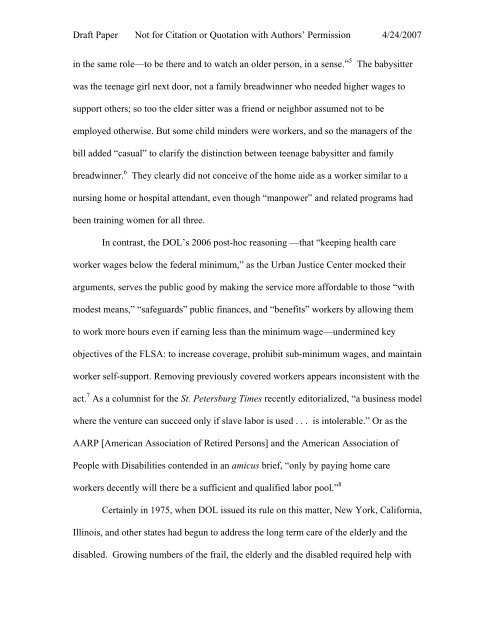Organizing Home Care: - School of Social Service Administration
Organizing Home Care: - School of Social Service Administration
Organizing Home Care: - School of Social Service Administration
You also want an ePaper? Increase the reach of your titles
YUMPU automatically turns print PDFs into web optimized ePapers that Google loves.
Draft Paper Not for Citation or Quotation with Authors’ Permission 4/24/2007<br />
in the same role—to be there and to watch an older person, in a sense.” 5<br />
The babysitter<br />
was the teenage girl next door, not a family breadwinner who needed higher wages to<br />
support others; so too the elder sitter was a friend or neighbor assumed not to be<br />
employed otherwise. But some child minders were workers, and so the managers <strong>of</strong> the<br />
bill added “casual” to clarify the distinction between teenage babysitter and family<br />
breadwinner. 6<br />
They clearly did not conceive <strong>of</strong> the home aide as a worker similar to a<br />
nursing home or hospital attendant, even though “manpower” and related programs had<br />
been training women for all three.<br />
In contrast, the DOL’s 2006 post-hoc reasoning —that “keeping health care<br />
worker wages below the federal minimum,” as the Urban Justice Center mocked their<br />
arguments, serves the public good by making the service more affordable to those “with<br />
modest means,” “safeguards” public finances, and “benefits” workers by allowing them<br />
to work more hours even if earning less than the minimum wage—undermined key<br />
objectives <strong>of</strong> the FLSA: to increase coverage, prohibit sub-minimum wages, and maintain<br />
worker self-support. Removing previously covered workers appears inconsistent with the<br />
act. 7 As a columnist for the St. Petersburg Times recently editorialized, “a business model<br />
where the venture can succeed only if slave labor is used . . . is intolerable.” Or as the<br />
AARP [American Association <strong>of</strong> Retired Persons] and the American Association <strong>of</strong><br />
People with Disabilities contended in an amicus brief, “only by paying home care<br />
workers decently will there be a sufficient and qualified labor pool.” 8<br />
Certainly in 1975, when DOL issued its rule on this matter, New York, California,<br />
Illinois, and other states had begun to address the long term care <strong>of</strong> the elderly and the<br />
disabled. Growing numbers <strong>of</strong> the frail, the elderly and the disabled required help with
















